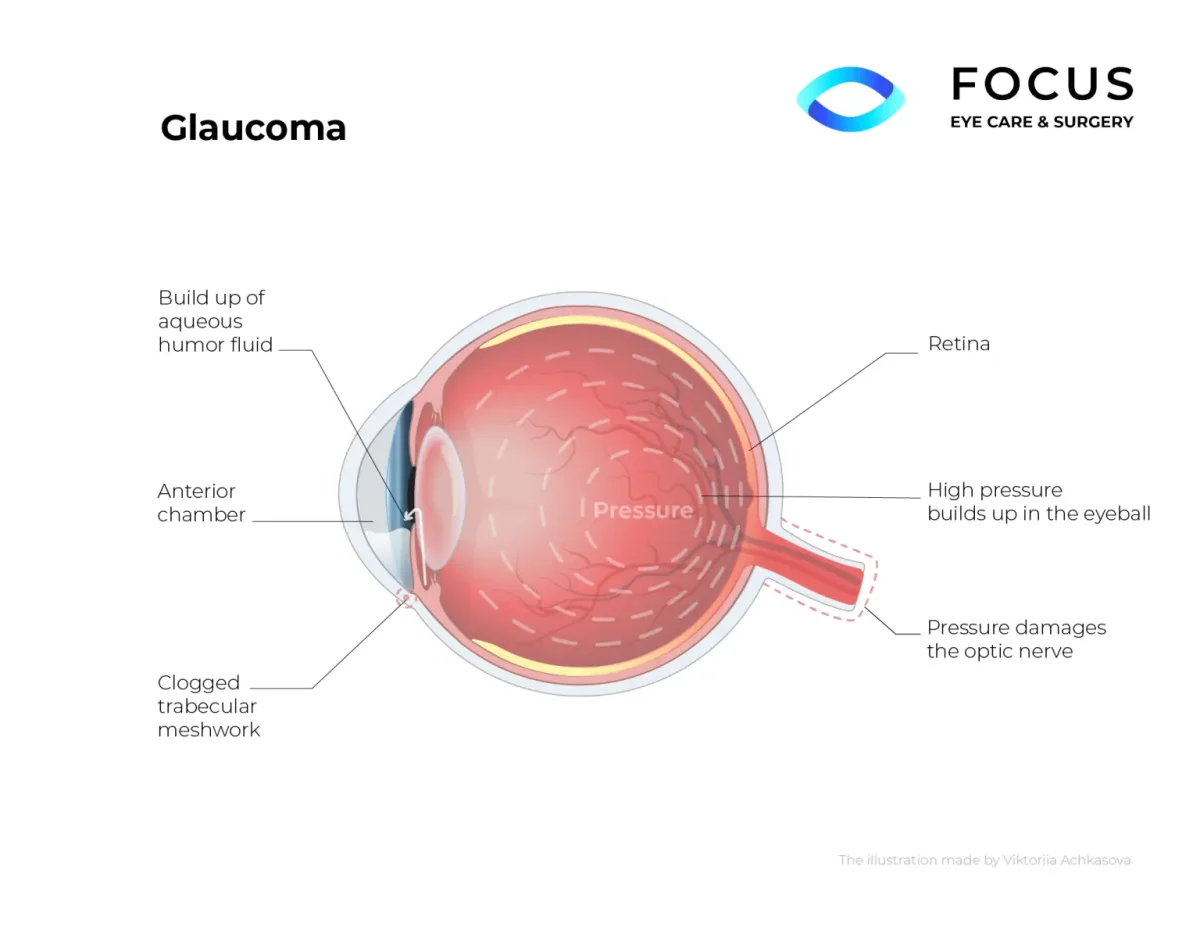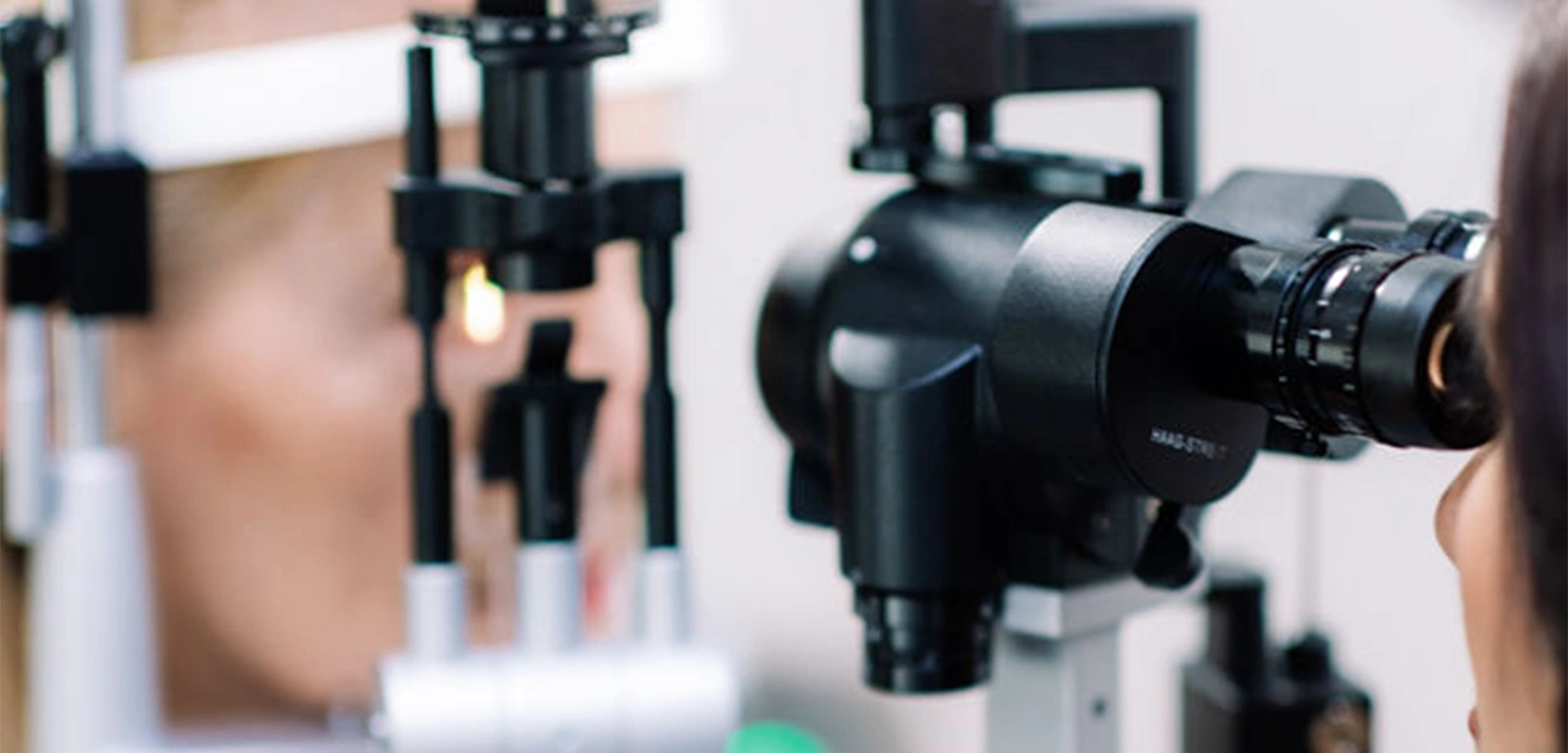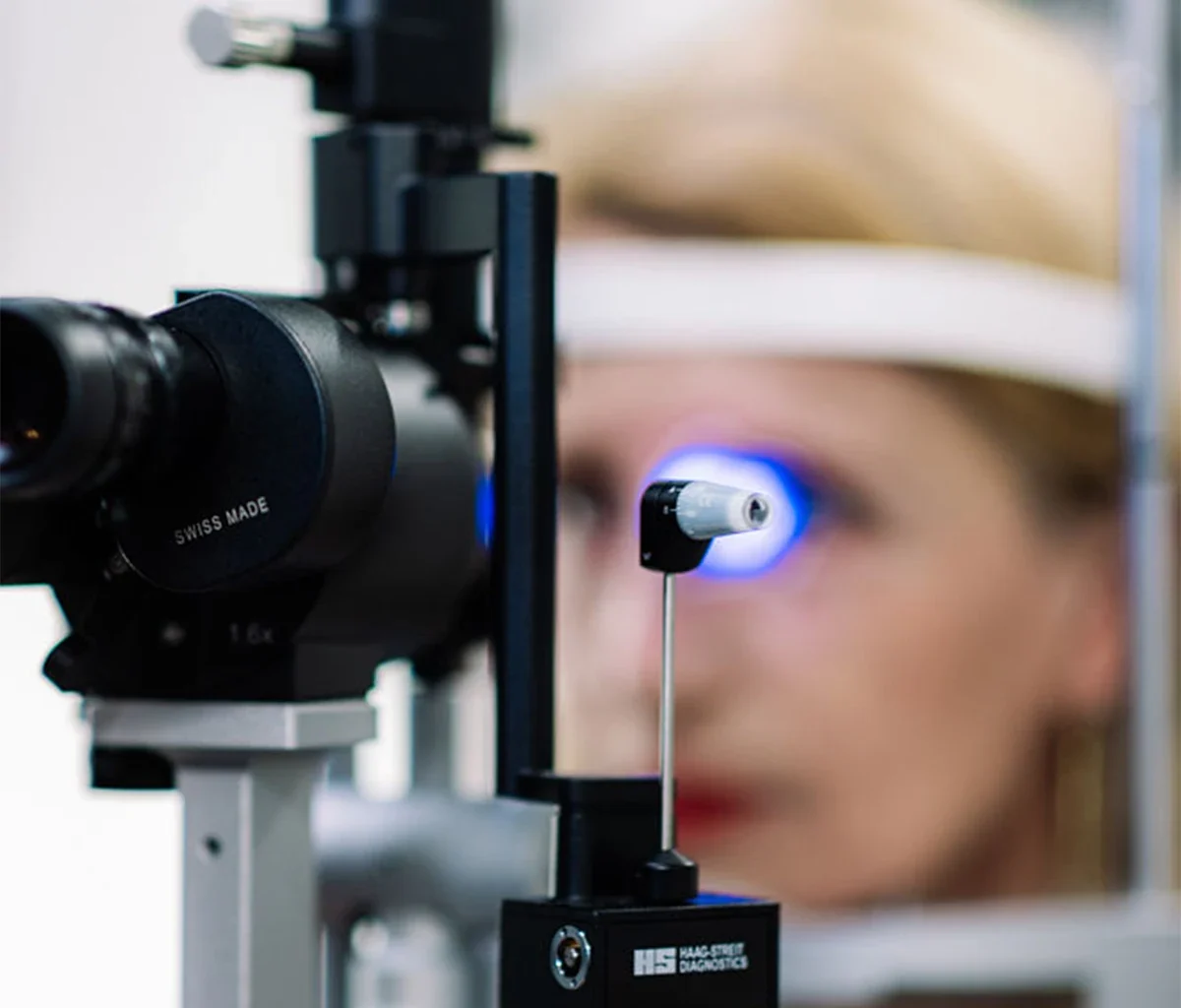
Glaucoma
Glaucoma
Your vision is one of your most valuable assets, and at Focus Eye Care & Surgery, we’re here to help you protect it. Dr. Neelofar Ghaznawi, a board-certified ophthalmologist and glaucoma specialist, provides advanced glaucoma care to patients in Queens and Long Island. With personalized treatment options and a compassionate approach, Dr. Ghaznawi is dedicated to preserving your vision and supporting your eye health.
What is Glaucoma?
Glaucoma refers to a group of eye diseases that damage the optic nerve, which is vital for transmitting visual information from the eye to the brain. This damage often occurs when intraocular pressure (IOP) increases due to an imbalance in the production and drainage of aqueous humor—the fluid that nourishes the eye. When the fluid builds up, it exerts pressure on the optic nerve, leading to progressive vision loss.
Known as the “silent thief of sight,” glaucoma often develops without obvious symptoms in its early stages. Many individuals are unaware they have the condition until significant vision loss occurs. It is estimated that more than 3 million Americans have glaucoma, and it is one of the leading causes of
Trusted Source
Don’t Let Glaucoma Steal Your Sight! Available: https://www
Centers for Disease Control and Prevention
Go to Source
blindness worldwide.
Regular eye exams and early intervention are essential to protect your vision and manage the disease effectively.



Glaucoma often develops due to increased intraocular pressure (IOP), which occurs when the eye’s natural fluid, called aqueous humor, fails to drain properly. This buildup of pressure can damage the optic nerve and result in vision loss. However, elevated eye pressure is not the only contributing factor. Some individuals with normal IOP may also develop glaucoma, suggesting that genetics, poor blood flow to the optic nerve, or other underlying conditions may play a role.
Because glaucoma has multiple potential causes, regular eye exams are essential for detecting early signs and assessing individual risk factors, even when eye pressure appears normal.
Types of Glaucoma
Glaucoma encompasses several distinct forms, each affecting the eye in different ways. The two most common types are open-angle glaucoma and closed-angle glaucoma, but there are other variations that also require attention and specialized management.
Open-Angle Glaucoma
Open-angle glaucoma is the most frequently diagnosed form of the condition. It occurs when the eye’s drainage system, known as the trabecular meshwork, becomes less effective at clearing fluid (aqueous humor). While the fluid can reach the drainage area, it does not exit properly, leading to a gradual increase in intraocular pressure. This form of glaucoma typically progresses slowly and without noticeable symptoms early on. Regular eye exams are essential to catch the disease before significant optic nerve damage and vision loss occur.
Closed-Angle Glaucoma
Closed-angle glaucoma, sometimes referred to as angle-closure glaucoma, happens when the drainage angle formed by the cornea and iris is obstructed. This blockage prevents the normal flow of aqueous humor, causing a sudden and dangerous rise in intraocular pressure. Symptoms often appear quickly and may include intense eye pain, blurred vision, halos around lights, nausea, and headaches. Because this type of glaucoma can lead to permanent vision loss if untreated, it is considered a medical emergency requiring prompt care.
Low-Tension Glaucoma
Low-tension glaucoma, or normal-tension glaucoma, is characterized by optic nerve damage despite normal intraocular pressure levels. The exact cause is unclear, but factors such as poor blood flow to the optic nerve may contribute. This form of glaucoma underscores the importance of comprehensive eye exams, as damage can progress without obvious pressure-related symptoms.
Secondary Glaucoma
Secondary glaucoma arises from an underlying condition or event, such as eye injuries, inflammation, or certain medications. Subtypes include:
- Congenital Glaucoma: Present at birth due to developmental abnormalities.
- Neovascular Glaucoma: Linked to abnormal blood vessel growth in the eye, often due to diabetes or retinal conditions.
- Pigmentary Glaucoma: Caused by pigment particles clogging the eye’s drainage system.
- Exfoliation Glaucoma: Results from a flaky material peeling off the lens and blocking drainage.
- Uveitic Glaucoma: Associated with inflammation in the eye
Trusted Source Types of Glaucoma National Eye Institute Go to Source (uveitis).
Each type of glaucoma requires tailored management to prevent irreversible damage, emphasizing the importance of early diagnosis and treatment.

Symptoms of Glaucoma
Glaucoma is often called the “silent thief of sight” because it can develop without noticeable symptoms, particularly in its most common form, open-angle glaucoma. Vision loss in these cases tends to progress gradually and painlessly, often starting with blind spots in peripheral vision. By the time symptoms are recognized, irreversible damage may have already occurred.
In contrast, closed-angle glaucoma can cause a rapid and severe onset of symptoms, including:
- Intense eye pain or pressure
- Blurred or distorted vision
- Rainbow-colored halos around lights
- Redness in the eyes
- Headaches
-
Trusted Source Glaucoma Cleveland Clinic Go to Source Nausea and vomiting
A “glaucoma attack” from closed-angle glaucoma is a medical emergency that requires immediate attention to prevent permanent vision loss. Because symptoms vary by type and stage of glaucoma—and because some individuals experience no warning signs—routine eye exams are vital for early detection and treatment. Early intervention is the best way to protect your vision and quality of life.
How is Glaucoma Diagnosed?
Diagnosing glaucoma involves a series of non-invasive tests designed to assess the health of the optic nerve, measure intraocular pressure (IOP), and evaluate peripheral vision. During a comprehensive eye exam, your eye doctor may perform a test called tonometry to measure IOP, as elevated pressure is a common indicator of glaucoma. A dilated eye exam allows for a detailed evaluation of the optic nerve to identify any signs of damage.
If your ophthalmologist suspects you have glaucoma, additional diagnostic tools may be used, including:
- Optical Coherence Tomography (OCT): Captures detailed images of the retinal nerve fiber layer to detect thinning.
- Visual Field Testing: Maps your peripheral vision to identify areas of vision loss.
- Gonioscopy: Examines the drainage angle of the eye to determine whether it is open or closed.
Early diagnosis is critical for preserving vision and preventing further damage. These advanced screening methods ensure a thorough evaluation, enabling timely intervention and effective management of the condition.

Glaucoma Treatment
The primary goal of glaucoma treatment is to lower intraocular pressure (IOP) to minimize damage to the optic nerve and slow the progression of vision loss. Although glaucoma cannot be cured, there are several effective options available to help manage the condition and protect your eyesight.
Glaucoma Medications
Prescription eye drops are often the first approach for managing glaucoma. These medications work by either decreasing the amount of fluid the eye produces or improving the outflow of fluid, helping to lower IOP. In some situations, oral medications may be recommended to complement or replace eye drops. Regular and consistent use of these treatments is vital to effectively manage the condition and preserve vision.
Laser Glaucoma Surgery
- Selective Laser Trabeculoplasty (SLT): This minimally invasive procedure is commonly recommended for open-angle glaucoma. Using laser energy, SLT targets the trabecular meshwork, enhancing fluid drainage and reducing eye pressure. The treatment is quick, virtually painless, and can often reduce or eliminate the need for long-term medications.
- Laser Peripheral Iridotomy (LPI): For patients with narrow-angle or closed-angle glaucoma, LPI creates a tiny opening in the outer edge of the iris. This allows fluid to flow freely, reducing pressure and preventing acute glaucoma attacks. LPI is a highly effective preventative and therapeutic option for angle-closure glaucoma.
Each treatment plan is tailored to the patient’s unique needs, with the goal of preserving vision and maintaining quality of life. Regular follow-up care is essential to monitor disease progression and adjust treatments as necessary.
FAQs About Glaucoma
Glaucoma can affect anyone, but certain factors may increase your likelihood of developing the condition. Regular eye exams are essential, especially if you fall into one or more of these higher-risk categories:
- Age: Risk increases significantly after age 60, with earlier onset in some cases.
- Race and Ethnicity: African Americans are at higher risk for glaucoma and often experience more severe forms of the disease. People of Asian descent are more likely to develop angle-closure glaucoma, while those of Japanese descent are prone to low-tension glaucoma.
- Family History: If a parent or sibling has glaucoma, your chances of developing it are significantly higher.
- Medical Conditions: Conditions like diabetes, high blood pressure, migraines, or sickle cell anemia may elevate your risk.
- Eye Trauma or Surgery: Previous eye injuries or surgeries can alter the eye’s internal structures, increasing the likelihood of glaucoma.
- Medications: Long-term use of corticosteroids, such as prednisone or cortisone, can lead to elevated eye pressure.
- Vision Conditions: Severe nearsightedness (myopia) or farsightedness (hyperopia) may contribute to glaucoma risk, even if corrected through procedures like
Trusted Source Glaucoma Mayo Clinic Go to Source LASIK.
While not everyone with these risk factors develops glaucoma, being aware of them and undergoing routine eye exams can lead to earlier detection and better management.
While glaucoma cannot be completely prevented, you can lower your risk by undergoing regular eye exams, especially if you are in a high-risk group. Early detection and treatment are essential to preserving vision. Additionally, managing conditions like high blood pressure or diabetes, staying active, wearing UV-protective sunglasses, and knowing your family history can help protect your eye health.
There is currently no cure for glaucoma. However, effective treatments, such as prescription eye drops, laser procedures, or surgery, can manage the condition by lowering intraocular pressure and slowing its progression. Early detection and a personalized treatment plan are key to preventing further vision loss.
Yes, glaucoma can lead to permanent vision loss and blindness if left untreated. Since glaucoma often progresses without noticeable symptoms, regular eye exams are critical to catching and managing the disease early.
It’s recommended that individuals at higher risk for glaucoma—such as those over 40, with a family history, or with other risk factors—schedule comprehensive eye exams every 1-2 years. Your eye doctor may advise more frequent checkups depending on your individual risk factors.
Unfortunately, damage to the optic nerve caused by glaucoma is permanent. Once vision is lost, it cannot be restored. This makes early diagnosis and treatment essential for preventing significant vision loss.
The cost of glaucoma treatment for our patients in Queens and Long Island depends on the specific type of treatment required and your insurance coverage. Since glaucoma treatment is considered medically necessary, most health insurance plans cover part of the costs. Your out-of-pocket expenses will vary based on the treatment plan your ophthalmologist prescribes and your insurance policy.


Contact Us
Protect your vision and take control of your eye health with comprehensive glaucoma care at Focus Eye Care & Surgery. Our experienced team is here to provide advanced diagnostics and personalized treatment options tailored to your needs.
Contact us today to schedule your appointment at our conveniently located offices serving Queens and Long Island.
The doctors at Focus Eye Care & Surgery have reviewed and approved this content.
Page Updated:
1 Centers for Disease Control and Prevention. Don’t Let Glaucoma Steal Your Sight! Available: https://https://www.cdc.gov/vision-health/about-eye-disorders/glaucoma.html. Accessed January 7, 2025.
2 National Eye Institute. Types of Glaucoma. Available: https://www.nei.nih.gov/learn-about-eye-health/eye-conditions-and-diseases/glaucoma/types-glaucoma. Accessed February 7, 2025.
3 Cleveland Clinic. Glaucoma. Available: https://my.clevelandclinic.org/health/diseases/4212-glaucoma. Accessed January 7, 2025.
4 Mayo Clinic. Glaucoma. Available: https://www.mayoclinic.org/diseases-conditions/glaucoma/symptoms-causes/syc-20372839 Accessed February 7, 2025.


